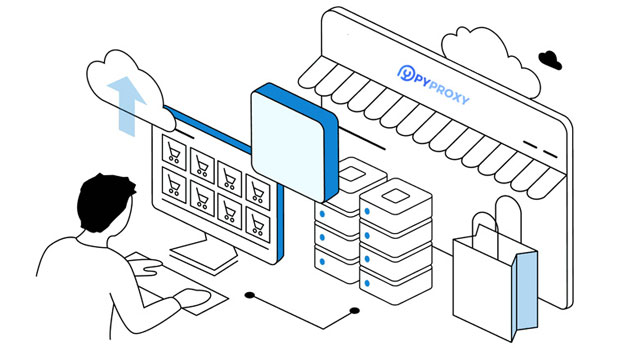When purchasing PYProxy proxies, how do I choose the best one for my data crawling needs?
When purchasing a proxy for data scraping, one of the biggest challenges is selecting the right proxy provider that aligns with your specific data collection requirements. PYPROXY, a popular proxy service, offers various proxy types designed to cater to different data scraping demands. In order to maximize efficiency, speed, and accuracy, it is essential to understand the key factors that should guide your choice. This article will walk you through the process of selecting the best proxy based on your needs, helping you make an informed decision that supports your data scraping goals. Understanding the Importance of Choosing the Right Proxy for Data ScrapingData scraping involves extracting large amounts of data from websites, a task that often requires bypassing restrictions such as IP blocks, CAPTCHAs, and rate limits. Therefore, having the right proxy can significantly improve your ability to gather data efficiently. Using the wrong proxy type can result in slow speeds, blocked IP addresses, or even data inconsistencies. It is crucial to consider a variety of factors when selecting the best proxy for data scraping, ensuring that your operation remains seamless and cost-effective.Types of Proxies and Their Suitability for Data ScrapingUnderstanding the different types of proxies and their features is fundamental to selecting the one that best suits your data scraping needs.1. residential proxies Residential proxies are IP addresses assigned by Internet Service Providers (ISPs) to homeowners. These proxies are often seen as legitimate by websites, making them less likely to get blocked. They are ideal for scraping websites that are heavily protected or have strict anti-bot measures in place. For tasks such as price comparison, social media monitoring, and search engine data extraction, residential proxies are often the best choice due to their high success rate in bypassing restrictions.2. Datacenter Proxies Datacenter proxies are not linked to ISPs but are instead generated from data centers. While they are faster and cheaper than residential proxies, they are more likely to be detected and blocked by websites due to their association with data centers. Datacenter proxies are best used for tasks that require high-speed scraping, such as retrieving public data from sites with minimal anti-bot measures or gathering large volumes of data in a short time frame.3. Mobile Proxies Mobile proxies provide IP addresses that are assigned to mobile devices, typically through mobile carriers. These proxies are effective for accessing content that is only available to mobile users or for performing mobile app scraping. Mobile proxies are particularly useful for scraping data from websites or apps that perform location-based targeting or have device-specific restrictions.4. Rotating Proxies Rotating proxies automatically change IP addresses at regular intervals, which helps in evading detection and blocking. For extensive data scraping projects where a high volume of requests is made, rotating proxies are essential. They are widely used in market research, competitor analysis, and ad verification, where constant access to a variety of IP addresses is required to avoid IP bans.Factors to Consider When Choosing the Best Proxy for Data ScrapingIn addition to understanding the different types of proxies, there are several key factors that should guide your decision when purchasing a proxy for data scraping.1. Proxy Speed and Performance The speed and performance of a proxy are crucial when scraping data. Slow proxies can lead to delays and incomplete data collection. When selecting a proxy, look for providers that offer fast and stable connections. The response time of the proxy can impact your scraping efficiency, especially for time-sensitive tasks or high-volume data scraping.2. Geographic Location of Proxies Depending on your scraping needs, the geographic location of the proxy may be important. If you're targeting data from a specific country or region, choosing proxies that are located in those areas can help you avoid geo-restrictions and improve data access. For example, if you're scraping localized content or targeting region-specific websites, you would benefit from proxies located in that region.3. IP Pool Size and Diversity A large and diverse IP pool is essential for data scraping, especially for projects that require continuous and large-scale scraping. The more IPs available in the pool, the lower the chances of getting blocked or flagged as a bot. Providers with a wide range of IP addresses from different regions and ISPs are better suited for complex data scraping tasks.4. Security and Anonymity Security is a major concern in data scraping, particularly when working with sensitive data. Ensure that the proxy provider offers strong security features, such as encrypted connections, to protect your data. Anonymity is also crucial, as revealing your identity or scraping patterns could lead to account bans or data leaks. Choose proxies that provide complete anonymity to safeguard your scraping operations.5. Customer Support and Service Quality The quality of customer support is another important factor to consider when selecting a proxy for data scraping. Efficient customer service ensures that you can quickly resolve any issues related to proxy downtime, connection problems, or technical support. Look for a proxy provider with a responsive and knowledgeable support team that can assist you whenever needed.6. Pricing and Budget Budget considerations are always important when selecting a proxy for data scraping. Residential proxies tend to be more expensive than datacenter proxies, but they offer higher success rates. If cost is a concern, evaluate the pricing plans and choose a provider that offers flexible options that fit your needs and budget.How to Select the Best Proxy for Your Specific Data Scraping ProjectTo ensure you select the most suitable proxy, follow these steps:1. Define Your Scraping Goals Start by identifying the goals of your data scraping project. Are you scraping a small dataset from a few websites, or do you need to gather vast amounts of data from multiple sources? Your goals will help determine the type of proxy you need. For example, if you're conducting high-volume scraping from multiple sites, rotating proxies or residential proxies might be the best fit.2. Assess the Websites You Are Scraping Consider the websites you will be targeting for scraping. Do they have advanced anti-bot measures, such as CAPTCHA or IP blocking? If so, residential or rotating proxies are likely to be more effective. On the other hand, if the websites you’re targeting have minimal protection, datacenter proxies may suffice.3. Test Proxy Providers Before committing to a long-term purchase, it's advisable to test different proxy providers. Many providers offer trial periods or money-back guarantees, which allow you to test the proxies and evaluate their performance based on your specific needs. Testing will give you insight into the proxy's speed, reliability, and success rate in bypassing restrictions.4. Monitor Your Scraping Performance Once you've selected a proxy, monitor your scraping performance regularly. Keep track of any IP blocks or slowdowns that might occur, and make adjustments if needed. You can switch proxies, increase the number of IPs, or change the proxy rotation schedule to optimize your scraping results.ConclusionSelecting the right proxy for your data scraping needs is a critical step in ensuring the success of your project. Whether you choose residential, datacenter, or rotating proxies depends on the specific requirements of your scraping tasks. By considering factors such as speed, IP pool size, security, and geographic location, you can make an informed decision that enhances your data collection efforts. Always test your chosen proxy and monitor its performance to ensure smooth and effective scraping operations. By carefully selecting the best proxy for your needs, you can avoid roadblocks and optimize your data scraping strategy.
2025-02-24
























































